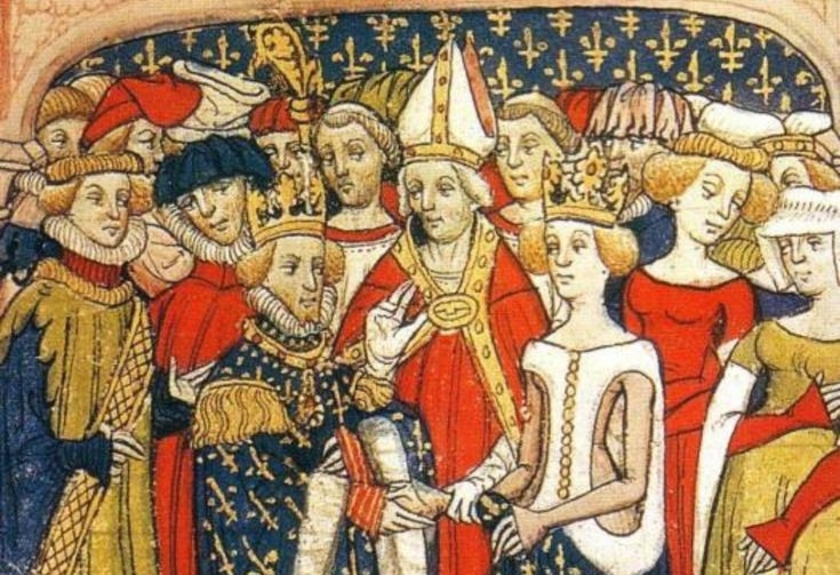Polygyny and Multiple Marriages in Later Medieval Ireland
Gaelic-Irish marital customs
Maria of Brabant's marriage, Manuscript Chroniques de France ou de St. Denis, British Library
Up until the Norman Invasion, there is a wealth of information in the saints lives to substantiate the theory that among the wealthy aristocrats in early Christian Ireland, polygyny (a form of marriage in which a man has two or more wives at the same time) was an accepted practice. It would appear that the church reform of the eleventh century succeeded in dismantling the ecclesiastical framework that supported polygyny, but did not succeed in swaying cultural attitudes over to the ecclesiastical doctrine that supported one monogamous, Christian marriage for life.
Gaelic-Irish marital customs did receive a large amount of criticism during the eleventh and twelfth centuries for basing these marriage customs not on church doctrine, but an older, Irish customary law. This attitude is adequately expressed in Art Cosgrove’s contribution to Marriage in Ireland (1985) when he states that “the Irish law on marriage – a law of fornication rather than a law of marriage according to Archbishop Lanfranc of Canterbury – permitted a man to keep a number of concubines, allowed divorce at will followed by the remarriage of either partner, and took no account of canonical prohibitions regarding consanguinity or affinity”. Thus, women as well as men were permitted to have more than one marriage in a lifetime.
It would appear that the restrictions on the number of times a person married was not related to any moral code, but the financial / political means of the person in question, which resulted in ‘resource polygyny’, an anthropological term applied to the practice of polygyny based on an abundance of resources or wealth. This freedom to marry more than once based solely on economic means may have helped to empower the aristocratic lady. Muireann Ni Bhrolchain has suggested that a woman might have been able to exert more influence in her successive marriages as divorce settlements could leave her with a substantial amount of acquired wealth.
Besides the Irish annals, a source for marriages in medieval Ireland is the Banshenchas, from which we know that in the eleventh century Derborgaill, granddaughter of the high king of Ossory, married six different men. This is the most marriages for a woman recorded in the Banshenchas, as other women had typically two or three, and occasionally four or five husbands. Ni Bhrolchain has noted that the annals interestingly omit Derborgaill’s six marriages in their treatment of her. Could this be the case for other women listed in the annals? Lasairfhiona Ni Conchobair, for example, is listed solely as the wife of Domhnaill Mor O Domhnaill in the annals, but as he died in 1241 and she outlived him by 41 years, it is possible that she could have contracted for marriage after O Domhnaill’s death, as she was an aristocratic lady of property and wealth and would have been attractive both as a means of political alliance and as a means to consolidate property.
Katherine O'Meara
Bibliography
The Annals of Clonmacnoise, ed. Denis Murphy (Dublin, 1896)
Annala Connacht: the Annals of Connaught, A. D. 1224-1544, ed. A. M. Freeman (Dublin, 1944)
Annala rioghachta Eireann: Annals of the kingdom of Ireland by the Four Masters, vol. 3, ed. John O’Donovan (Dublin, 1856)
The Annals of Loch Ce, vol. 2, ed. William M. Hennessey (London, 1871)
Muireann Ni Bhrolchain, ‘The Banshenchas Revisted’, in Mary O’Dowd & Sabine Wighert, (eds.), Chattel, Servant or Citizen: Women’s Status in Church, State, and Society (Belfast, 1995)
Art Cosgrove, ‘Marriage in Medieval Ireland’ in Art Cosgrove (ed.), Marriage in Ireland (Dublin, 1985)
David Herlihy, Medieval Households (London, 1985)
Fergus Kelly, A Guide to Early Irish Law (Dublin, 1995)

